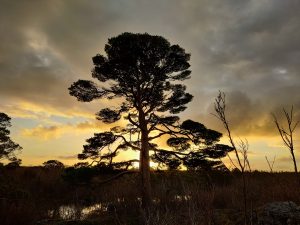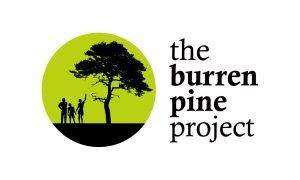The Burren Pine Project
Restoring a ‘lost’ species to Ireland’s natural flora
The Burrenbeo Trust, Ireland’s only landscape conservation charity is delighted to announce an exclusive opportunity for people and businesses to invest in a unique ecological restoration project in Ireland’s greatest repository of natural and cultural heritage, the Burren.
Sponsor the restoration of native pine in the Burren
The remarkable re-discovery of Ireland’s native pine after 1,500 years
The beautiful Pinus sylvestris is Ireland’s only native pine tree which, according to pollen and archaeological records, once dominated the Burren landscape. Thought to have died out in Ireland around 1,500 years ago, it was later reintroduced from Scotland, leading to its common name ‘Scot’s pine’. Thrillingly however, recent investigations by scientists at Trinity College Dublin confirmed the presence of a ‘microrefugium’ of native pine trees at a remote site in the Burren, Co. Clare. This remarkable find was verified by pollen analyses and the details published in a peer reviewed paper.
This latest research has confirmed that the Burren supports the only confirmed native stand of pine trees and that this ”native population of pine trees is of high conservation value but its rarity increases its extinction risk. Cooperation between forestry and nature conservation agencies is needed to ensure its continued survival and to develop opportunities for the restoration of native pinewoods in Ireland.”
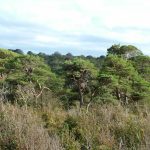
A unique ecological restoration opportunity for businesses & individuals
Our ambition at the Burrenbeo Trust is to help restore these pine-dominated woodland communities in the Burren and we invite like-minded individuals and businesses to join hands with us in achieving this goal. Your sponsorship will enable us to plant a number of small (100 pine trees) ‘mini-forests’ across the region.
These mini-forests, in close proximity to the original site, will act as nurseries for the native pine trees, the seeds from which will be a valuable resource for the future expansion of the species in Ireland, reducing its vulnerability to extinction.
These rare trees represent a genetic resource of inestimable value which you now have an opportunity to protect.
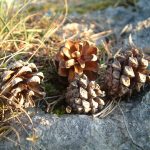
Hundreds of young trees now ready for planting
Seeds from the isolated population of native pines in the Burren have been collected under license from the National Parks and Wildlife Service, nurtured and grown in a local nursery in individual pots, and are now ready to be planted out. We have identified several local landowners who are generously willing to donate small plots of land to host these trees in perpetuity. We also have a team of conservation volunteers who will plant, protect and manage the trees and the sites. Additionally, all income generated will be used to support Burrenbeo’s award-winning conservation work.
Help us restore the Burren pine
We are now seeking investors to fund ‘The Burren Pine Project’. Our ambition is to plant 500 native pine trees per year but we need your support to do so.
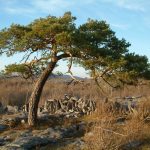
For every €100 invested we will
- Plant one native pine tree along with 3-4 native ‘companion species’, covering the cost of the trees, the land on which they will grow (species-poor land, so no biodiversity loss) and their (chemical-free) maintenance.
- Issue a certificate to confirm the purchase of the pine tree(s) and its unique identifier which will be linked to a database of trees containing planting date, location, maintenance work etc.
- Invite you to participate in annual events relating to the planted trees.
- Provide annual updates (including images) of your tree(s)
- Publish and acknowledge, if agreeable to the investor, their name and/or (company) logo in some of the Burrenbeo Trust’s digital outlets.
- Use the remaining funds to support Burrenbeo Trust’s work in shaping a brighter future for the communities of the Burren and their special place.
View the full Terms and Conditions of Burrenbeo’s Burren Pine Project™ offer
Corporate and individual sponsorship now available
Visit our Online Shop now to sponsor one or more Burren pine trees for restoration. Burrenbeo will provide certificates for the tree/s planted, provide regular updates on the status of the mini-forests and invite you to participate in annual events relating to the planted trees. This offer is available on a first come, first served basis, the perfect gift for family, friends or staff.
To avail of our Corporate Sponsorship package of restoring 50 or more trees, please download, complete and return this Corporate Sponsorship Request form. Find out more about the Business Supporters of the Burren Pine Project.
Other ways to give
The Burren Pine Project is proud to be a part of the 1% for the Planet network, which connects businesses and nonprofits to protect the planet. If you own a business, consider joining 1% for the Planet, naming The Burrenbeo Trust as your beneficiary. Everyone wins! More info at onepercentfortheplanet.org
Sponsor the restoration of native pine in the Burren
Supplementary Information:
Archaeological evidence:
Two shell middens/habitation sites at Fanore More were excavated between 2009 and 2014 by Michael Lynch with the assistance of the Burrenbeo Conservation Volunteers. Radiocarbon dates from the sites show them to be Later Mesolithic ranging from approximately 6,000 to 7,000 years ago. The charcoal analysis was carried out by archaeobotanist Mary Dillon. This showed that over 80% of the charcoal from Site 1 and over 95% from Site 2 was Scots Pine (Pinus Sylvesteris). The analysis also showed that most of the charcoal came from large branches or tree trunks rather than small branches and twigs. Pollen analysis has shown that Scots Pine would have been a dominant tree species in the area at that time. This high percentage of Scots Pine use as firewood on an archaeological site in Ireland is most unusual. It reveals a special relationship between the Mesolithic hunter-gatherers of north-west Clare and this iconic tree.
The charcoal from sites one and two have been analysed. The most remarkable and significant results from both sites is the complete dominance of Scots pine as the choice of wood for fuel: it accounted for 85% of the charcoal from site 1 along with small amounts of yew, hazel and oak, while this proportion increased to 95.9% at site 2, with birch and willow or poplar making up the remainder. It is difficult to explain this phenomenon which is unique in Irish archaeology and any attempt at interpretation will have to wait until completion of the remaining analyses, such of those as the burnt stone and burnt shelli
[i] Lynch. M. 2017 The Later Mesolithic on the north-west Coast of Clare. Archaeology Ireland 31 (4) No.122.24/28.
[ii] Dillon. M. 2016 Charcoal Analysis from Fanore More 2 unpublished report.
Links to further Resources :
Michael Viney: The mystery of the Irish ‘Scots’ pine, The Irish Times, Feb 4th 2017
Recent findings on the native status and vegetation ecology of Scots pine in Ireland and their implications
for forestry policy and management – Jenni R. Roche

